INSTITUT SUPERIEUR D'ANTHROPOLOGIE
INSTITUTE OF ANTHROPOLOGY
ONLINE COURSES / COURS A DISTANCE
WINTER TERM : JANUARY 2015
REGISTER NOW
TURQUIE – 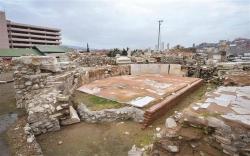 Izmir - The İzmir Agora excavations have unearthed the Smyrna assembly, where decisions were made during the Roman Empire. The excavations have been carried out by Dokuz Eylül University Archaeology Department’s Smyrna Ancient City excavation team and, so far, 50 percent of the area has been unearthed. The agora is expected to be completely unearthed in the next five years. The excavation team is now working on the City Assembly structure, called Bouleuterion. The podium, lectern and two-step sitting places have so far been restored and put under protection. The 2nd century A.D. assembly, where the decisions on city administration were made, is large enough for the gathering of some 400 assembly members. The confiscation of the Agora began in 1997 and the first destruction was made in 2005.The agora of Smyrna was built during the Hellenistic era at the base of the Pagos Hill, the highest hill in ancient İzmir. It was the commercial, judicial and political nucleus of the ancient city. After a destructive earthquake in 178 AD, Smyrna was rebuilt in the Roman period and used until the Byzantine period.Within the scope of the Smyrna Agora Ancient Site Safety Wall project that has been approved by the İzmir Committee for the Protection of Cultural and Natural Properties, the historic Agora was integrated with the crowded İkiçeşmelik Street after confiscation and destruction works.
Izmir - The İzmir Agora excavations have unearthed the Smyrna assembly, where decisions were made during the Roman Empire. The excavations have been carried out by Dokuz Eylül University Archaeology Department’s Smyrna Ancient City excavation team and, so far, 50 percent of the area has been unearthed. The agora is expected to be completely unearthed in the next five years. The excavation team is now working on the City Assembly structure, called Bouleuterion. The podium, lectern and two-step sitting places have so far been restored and put under protection. The 2nd century A.D. assembly, where the decisions on city administration were made, is large enough for the gathering of some 400 assembly members. The confiscation of the Agora began in 1997 and the first destruction was made in 2005.The agora of Smyrna was built during the Hellenistic era at the base of the Pagos Hill, the highest hill in ancient İzmir. It was the commercial, judicial and political nucleus of the ancient city. After a destructive earthquake in 178 AD, Smyrna was rebuilt in the Roman period and used until the Byzantine period.Within the scope of the Smyrna Agora Ancient Site Safety Wall project that has been approved by the İzmir Committee for the Protection of Cultural and Natural Properties, the historic Agora was integrated with the crowded İkiçeşmelik Street after confiscation and destruction works.
http://www.hurriyetdailynews.com/assembly-of-romans-finally-comes-to-light.aspx?pageID=238&nID=75980&NewsCatID=375
INDE - Malkapuram - A huge stone inscription, 20 feet in length and with a radius of 90 cm has been found in Malkapuram of Tullur. Though the inscription was found by the Archaeological Survey of India some time ago, little attention was paid to it. It was lying neglected with few having any knowledge about it till now. But due to the efforts of the department of archaeology and the museums of AP, it is back in focus and all set to gain due attention. S. Bangaraiah, assistant director, department of archaeology and museums, said that the inscription showed the foresight of Rani Rudrama Devi, a prominent Kakatiya dynasty ruler, who had set up maternity centres as early as in the 13th century.
http://www.deccanchronicle.com/141223/nation-current-affairs/article/kakatiya-inscription-found-malkapuram
PEROU – 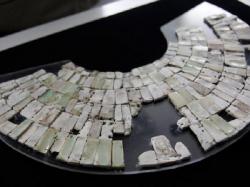 Lambayeque - A pending contribution of US$ 70,000 by the German government will go into preserving grave goods devoted to the Chornancap priestess of the Lambayeque culture unearthed two years ago. Since an archaeological team from Brüning Archaeological Museum, of Lambayeque, discovered the burial in the small palace complex of Chotuna-Chornancap, they have been working to conserve and hold the abundance of artifacts excavated. Nearly half of the restoration and preservation work on the burial paraphernalia has been completed however, and therefore more funding is needed to ensure the project is taken care of. The priestess, who lived to be around 25-30 years of age, was buried with ornate jewels, ceramic offerings, and gold and silver ritual artifacts. The fact that this kind of burial was not common in this time or region contributes to the notion that she was a priestess or important female figure in this society.
Lambayeque - A pending contribution of US$ 70,000 by the German government will go into preserving grave goods devoted to the Chornancap priestess of the Lambayeque culture unearthed two years ago. Since an archaeological team from Brüning Archaeological Museum, of Lambayeque, discovered the burial in the small palace complex of Chotuna-Chornancap, they have been working to conserve and hold the abundance of artifacts excavated. Nearly half of the restoration and preservation work on the burial paraphernalia has been completed however, and therefore more funding is needed to ensure the project is taken care of. The priestess, who lived to be around 25-30 years of age, was buried with ornate jewels, ceramic offerings, and gold and silver ritual artifacts. The fact that this kind of burial was not common in this time or region contributes to the notion that she was a priestess or important female figure in this society.
http://www.peruthisweek.com/news-germany-to-provide-funding-to-preserve-archaeological-grave-goods-104827
ROYAUME UNI - 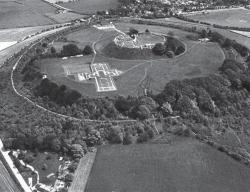 Camp Hill - Construction of a new reservoir by Wessex Water at Camp Hill as part of its £230 million water supply grid scheme has unearthed the remains of an Iron Age settlement.Wessex Water said it expected to find archaeological remains on the site near Salisbury so commissioned AC Archaeology to dig the area. A large Iron Age settlement dating from at least 50BC was uncovered, including Roman pots, military spears, and the skeleton of a woman. Wessex Water is constructing a new reservoir at Camp Hill adjacent to the existing one already in the location to help meet future demands of water supply over the next 25 years without having to develop new resources.
Camp Hill - Construction of a new reservoir by Wessex Water at Camp Hill as part of its £230 million water supply grid scheme has unearthed the remains of an Iron Age settlement.Wessex Water said it expected to find archaeological remains on the site near Salisbury so commissioned AC Archaeology to dig the area. A large Iron Age settlement dating from at least 50BC was uncovered, including Roman pots, military spears, and the skeleton of a woman. Wessex Water is constructing a new reservoir at Camp Hill adjacent to the existing one already in the location to help meet future demands of water supply over the next 25 years without having to develop new resources.
http://www.utilityweek.co.uk/news/wessex-water-unearths-iron-age-settlement/1085482?#.VJmggl4AEA
GRECE – 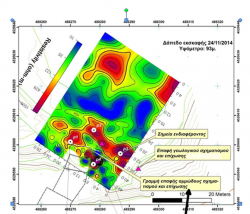 Amphipolis - The preliminary results of the geophysical scanning of Kasta Hill in Amphipolis, where the enigmatic ancient Greek tomb has been discovered, will prove to be indispensable in highlighting future archeological efforts. the Ministry of Culture’s statement regarding the preliminary results of the scan it is argued that the area adjacent to the fourth chamber of the tomb may reveal further treasures. The scan shows that there is an ancient opening to the northeast of the chamber and an artificial embankment. It is not clear how deep the opening is, but it appears that the archeologists will examine the area. As the geophysical survey continues and highlights greater details of the hill and the man-made interventions, the archeologists will be determine where to focus their excavation efforts next.
Amphipolis - The preliminary results of the geophysical scanning of Kasta Hill in Amphipolis, where the enigmatic ancient Greek tomb has been discovered, will prove to be indispensable in highlighting future archeological efforts. the Ministry of Culture’s statement regarding the preliminary results of the scan it is argued that the area adjacent to the fourth chamber of the tomb may reveal further treasures. The scan shows that there is an ancient opening to the northeast of the chamber and an artificial embankment. It is not clear how deep the opening is, but it appears that the archeologists will examine the area. As the geophysical survey continues and highlights greater details of the hill and the man-made interventions, the archeologists will be determine where to focus their excavation efforts next.
http://www.tovima.gr/en/article/?aid=661987
GRECE – 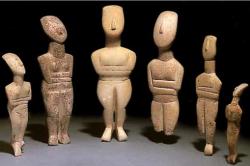 Naxos - An important early Bronze Age settlement and sanctuary on the now uninhabited Cycladic island of Keros was examined by excavation in 2006-2008, and by surface survey in 2012-2013. A new project in 2015 will begin with surface survey on the neighbouring, much larger island of Naxos. The aim is to understand the maritime hinterland of the Keros sanctuary, and to reconstruct the settlement network in Naxos in the early bronze age and in later times. This will be followed by new excavations at Keros in 2016. The work in 2015 is divided into two three-week seasons. The first begins on 4 May and continues to 23 May (inclusive). After a break survey resumes from 14 September to 3 October (inclusive). The team shall be based on the nearby island of Kouphonisi and travel daily by caique to Naxos. The daily schedule involves (sometimes strenuous) walking to the day’s survey zone, then structured survey over the area. Areas of interest, identified through surface features and remains of material culture, will be further surveyed in a more intensive fashion. The focus will be on the southern coast of Naxos, between the areas of Panormos, Spedos and Kallandos.
Naxos - An important early Bronze Age settlement and sanctuary on the now uninhabited Cycladic island of Keros was examined by excavation in 2006-2008, and by surface survey in 2012-2013. A new project in 2015 will begin with surface survey on the neighbouring, much larger island of Naxos. The aim is to understand the maritime hinterland of the Keros sanctuary, and to reconstruct the settlement network in Naxos in the early bronze age and in later times. This will be followed by new excavations at Keros in 2016. The work in 2015 is divided into two three-week seasons. The first begins on 4 May and continues to 23 May (inclusive). After a break survey resumes from 14 September to 3 October (inclusive). The team shall be based on the nearby island of Kouphonisi and travel daily by caique to Naxos. The daily schedule involves (sometimes strenuous) walking to the day’s survey zone, then structured survey over the area. Areas of interest, identified through surface features and remains of material culture, will be further surveyed in a more intensive fashion. The focus will be on the southern coast of Naxos, between the areas of Panormos, Spedos and Kallandos.
http://www.archaeology.wiki/blog/2014/12/23/southeast-naxos-survey-2015/